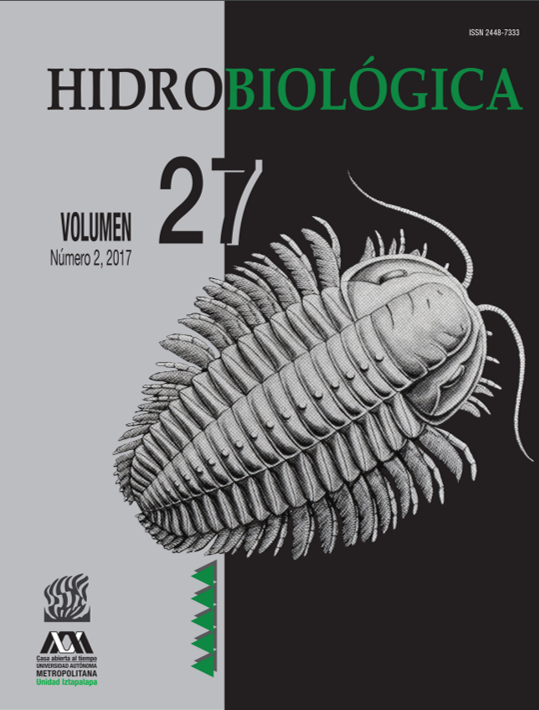Selectivity of Incilius valliceps (Anura: Bufonidae) tadpoles on freshwater zooplankton
DOI:
https://doi.org/10.24275/uam/izt/dcbs/hidro/2017v27n2/CervantesMPalabras clave:
Aquatic, feeding, freshwater, preferences, tropical zooplanktonResumen
The dietary preferences of tropical tadpoles and the way they interact with zooplankton often go unstudied in aquatic ecosystems. Goals. We investigated the interactions between Incilius valliceps tadpoles and a freshwater zooplankton community found in an artificial aquatic pond located on Cozumel Island in Quintana Roo, Mexico. Methods. We determined zooplankton abundance, richness, the Shannon-Wiener diversity index, and the proportion of each zooplankton species in the environment. We also evaluated characteristics of the tadpole population such as body size, abundance, and proportion of prey ingested as determined by stomach content analysis. We used the Jacobs selectivity index to determine tadpole prey of preference. Results. The rotifers Anuraeopsis fissa and an unidentified species of Bdelloidea group were dominant among the eight zooplankton species consumed. The selectivity index showed that I. valliceps tadpoles preferred to consume macro-zooplankton (ostracods and cladocerans) instead of the rotifer species available. Tadpoles positively chose Cypridopsis vidua throughout their growth and development and Moina wierzejskii during their early developmental stages, and negatively selected the rotifer species of the one unidentified species of Bdelloidea, A. fissa, and Epiphanes brachionus. In the presence of tadpoles, Keratella americana, Lepadella patella, and Lecane luna were either present in extremely low abundances or not found in the aquatic community, and M. wierzejskii produced males and resistant eggs. Conclusions. The findings of this study clarify the dietary needs of tropical tadpoles and their role in aquatic ecosystems.Descargas
Descargas
Cómo citar
Número
Sección
Licencia
Los autores/as que publiquen en esta revista aceptan las siguientes condiciones:
De acuerdo con la legislación de derechos de autor, HIDROBIOLÓGICA reconoce y respeta el derecho moral de los autores, así como la titularidad del derecho patrimonial, el cual será cedido a la revista para su difusión en acceso abierto.
Publicar en la revista HIDROBIOLÓGICA tiene un costo de recuperación de $500 pesos mexicanos por página en blanco y negro (aproximadamente 29 dólares americanos) y $1000 pesos por página a color (aproximadamente 58 dólares americanos).
Todos los textos publicados por HIDROBIOLÓGICA sin excepción se distribuyen amparados bajo la licencia Creative Commons 4.0Atribución-No Comercial (CC BY-NC 4.0 Internacional), que permite a terceros utilizar lo publicado siempre que mencionen la autoría del trabajo y a la primera publicación en esta revista.
Los autores/as pueden realizar otros acuerdos contractuales independientes y adicionales para la distribución no exclusiva de la versión del artículo publicado en HIDROBIOLÓGICA (por ejemplo incluirlo en un repositorio institucional o publicarlo en un libro) siempre que indiquen claramente que el trabajo se publicó por primera vez en HIDROBIOLÓGICA.
Para todo lo anterior, el o los autor(es) deben remitir el formato de Carta-Cesión de la Propiedad de los Derechos de la primera publicación debidamente requisitado y firmado por el autor(es). Este formato se puede enviar por correo electrónico en archivo pdf al correo: enlacerebvistahidrobiológica@gmail.com; rehb@xanum.uam.mx (Carta-Cesión de Propiedad de Derechos de Autor).
Esta obra está bajo una licencia de Creative Commons Reconocimiento-No Comercial 4.0 Internacional.


